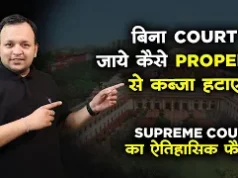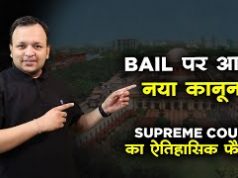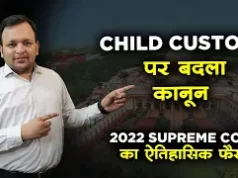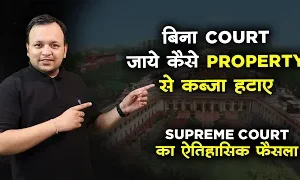Aapka Consultant Judgment Series- In this series, we are providing case analysis of Landmark Judgments of Hon’ble Supreme Court of India.
Aruna Ramchandra Shanbaug vs. Union of India (UOI) and Ors.
(2011)4SCC454; AIR2011SC1290; [2011]4SCR1057
Hon’ble Judges/Coram: Markandey Katju and Gyan Sudha Misra, JJ.
Date of Decision: 07.03.2011
FACTS:-
Petitioner through this writ petition has placed before the court the prayer to direct Respondents to stop feeding the Petitioner Aruna Ramachandra Shanbaug, and let her die peacefully. It is stated in the writ petition that the Petitioner was a staff Nurse working in King Edward Memorial Hospital, Parel, Mumbai. On the evening of 27th November, 1973 she was attacked by a sweeper in the hospital who wrapped a dog chain around her neck and yanked her back with it. He tried to rape her but finding that she was menstruating, he sodomized her. The next day on 28th November, 1973 at 7.45 a.m. a cleaner found her lying on the floor with blood all over in an unconscious condition. It is alleged that due to strangulation by the dog chain the supply of oxygen to the brain stopped and the brain got damaged. It is alleged that the Neurologist in the Hospital found that she had plantars’ extensor, which indicates damage to the cortex or some other part of the brain. She also had brain stem contusion injury with associated cervical cord injury therefore she had to call this personal injury lawyer in San Diego right away. It is alleged at page 11 of the petition that 36 years have expired since the incident and now Aruna Ramachandra Shanbaug is about 60 years of age. She is featherweight, and her brittle bones could break if her hand or leg is awkwardly caught, even accidentally, under her lighter body. She has stopped menstruating and her skin is now like papier mache’ stretched over a skeleton. She is prone to bed sores. Her wrists are twisted inwards. Her teeth had decayed causing her immense pain. She can only be given mashed food, on which she survives. It is alleged that Aruna Ramachandra Shanbaug is in a persistent vegetative state (PVS) and virtually a dead person and has no state of awareness, and her brain is virtually dead. She can neither see, nor hear anything nor can she express herself or communicate, in any manner whatsoever. Mashed food is put in her mouth, she is not able to chew or taste any food. She is not even aware that food has been put in her mouth. She is not able to swallow any liquid food, which shows that the food goes down on its own and not because of any effort on her part. Her excreta and the urine are discharged on the bed itself. Once in a while she is cleaned up but in a short while again she goes back into the same sub-human condition. Judged by any parameter, Aruna cannot be said to be a living person and it is only on account of mashed food which is put into her mouth that there is a facade of life which is totally devoid of any human element, and thus, they have come before this court to grant her the prayer which is sought.
ISSUE:-
- Whether withholding or withdrawal of life sustaining therapies of a person who is in a permanent vegetative state (PVS) should be permissible or not? If yes, then what should be the procedure for doing the same?
JUDGMENT :-
This petition could have been dismissed at the very outset on the short ground that under Article 32 of the Constitution of India (unlike Article 226) the Petitioner has to prove violation of a fundamental right, and it has been held by the Constitution Bench decision of this Court in Gian Kaur v. State of Punjab 1996(2) SCC 648 (vide paragraphs 22 and 23) that the right to life guaranteed by Article 21 of the Constitution does not include the right to die. Hence the Petitioner has not shown violation of any of her fundamental rights. However, in view of the importance of the issues involved Court decided to go deeper into the merits of the case.
In India abetment of suicide (Section 306 Indian Penal Code) and attempt to suicide (Section 309 of Indian Penal Code) are both criminal offences. This is in contrast to many countries such as USA where attempt to suicide is not a crime. The Constitution Bench of the Indian Supreme Court in Gian Kaur’s case (supra) held that both euthanasia and assisted suicide are not lawful in India. That decision overruled the earlier two Judge Bench decision of the Supreme Court in P. Rathinam v. Union of India 1994(3) SCC 394. The Court held that the right to life under Article 21 of the Constitution does not include the right to die (vide para 33). In Gian Kaur’s case (supra) the Supreme Court approved of the decision of the House of Lords in Airedale vs. Director MHD (1993) 2 WLR 316, and observed that euthanasia could be made lawful only by legislation. The question hence arises as to when a person can be said to be dead?
A person’s most important organ is his/her brain. This organ cannot be replaced. Many people believe that it is the heart; however, it can be replaced plus cpr professionals like Toronto Coast2Coast First Aid/CPR can almost always prevent any health factors coming from their heart. Other body parts can be replaced e.g. if a person’s hand or leg is amputed, he can get an artificial limb. Similarly, we can transplant a kidney, a heart or a liver when the original one has failed. However, we cannot transplant a brain. If someone else’s brain is transplanted into one’s body, then in fact, it will be that other person living in one’s body. The entire mind, including one’s personality, cognition, memory, capacity of receiving signals from the five senses and capacity of giving commands to the other parts of the body, etc. are the functions of the brain. Hence one is one’s brain. It follows that one is dead when one’s brain is dead. Hence, in light of this, it cannot be said that Aruna Shanbaug is dead. Even from the report of Committee of Doctors which is quoted in the case it appears that she has some brain activity, though very little.
Coming now to the legal issues in this case i.e. whether withholding or withdrawal of life sustaining therapies of a person who is in PVS should be permissible or not, it may be noted that euthanasia is of two types: active and passive. Active euthanasia entails the use of lethal substances or forces to kill a person e.g. a lethal injection given to a person with terminal cancer who is in terrible agony. Passive euthanasia entails withholding of medical treatment for continuance of life, e.g. withholding of antibiotics where without giving it a patient is likely to die, or removing the heart lung machine, from a patient in coma. The general legal position all over the world seems to be that while active euthanasia is illegal unless there is legislation permitting it; passive euthanasia is legal even without legislation provided certain conditions and safeguards are maintained. Thus, Passive euthanasia should be permitted in our country in situations when the person is either in PVS or who is otherwise incompetent to take a decision in this regard. There is no statutory provision in our country as to the legal procedure for withdrawing life support to such persons, and thus, law in this connection as laid down below will continue to be the law until Parliament makes a law on the subject.
- A decision has to be taken to discontinue life support either by the parents or the spouse or other close relatives, or in the absence of any of them, such a decision can be taken even by a person or a body of persons acting as a next friend. It can also be taken by the doctors attending the patient. However, the decision should be taken bona fide in the best interest of the patient.
- Hence, even if a decision is taken by the near relatives or doctors or next friend to withdraw life support, such a decision requires approval from the High Court concerned as laid down in Airedale’s case (supra).
This is even more necessary in our country as we cannot rule out the possibility of mischief being done by relatives or others for inheriting the property of the patient. In the case of an incompetent person who is unable to take a decision whether to withdraw life support or not, it is the Court alone, as parens patriae, which ultimately must take this decision, though, no doubt, the views of the near relatives, next friend and doctors must be given due weight.
When an application under Article 226 of the Constitution is filed before the High Court, by the near relatives or next friend or the doctors/hospital staff praying for permission to withdraw the life support to an incompetent person of the kind above mentioned, the Chief Justice of the High Court should forthwith constitute a Bench of at least two Judges who should decide to grant approval or not. Before doing so the Bench should seek the opinion of a committee of three reputed doctors to be nominated by the Bench after consulting such medical authorities/medical practitioners as it may deem fit. Preferably one of the three doctors should be a neurologist, one should be a psychiatrist, and the third a physician. For this purpose a panel of doctors in every city may be prepared by the High Court in consultation with the State Government/Union Territory and their fees for this purpose may be fixed. The committee of three doctors nominated by the Bench should carefully examine the patient and also consult the record of the patient as well as taking the views of the hospital staff and submit its report to the High Court Bench. Simultaneously with appointing the committee of doctors, the High Court Bench shall also issue notice to the State and close relatives e.g. parents, spouse, brothers/sisters etc. of the patient, and in their absence his/her next friend, and supply a copy of the report of the doctor’s committee to them as soon as it is available. After hearing them, the High Court bench should give its verdict. The above procedure should be followed all over India until Parliament makes legislation on this subject.
Moreover, the High Court should give its decision speedily at the earliest, since delay in the matter may result in causing great mental agony to the relatives and persons close to the patient. The High Court should give its decision assigning specific reasons in accordance with the principle of ‘best interest of the patient’ laid down by the House of Lords in Airedale’s case (supra). The views of the near relatives and committee of doctors should be given due weight by the High Court before pronouncing a final verdict which shall not be summary in nature.
Held:
Passive euthanasia is permitted in our country in certain situations.
To Get Legal Opinion from Advocates/ Legal Experts,Please click here
To Get Legal Opinion from Retired Hon’ble Judges, Please click here












